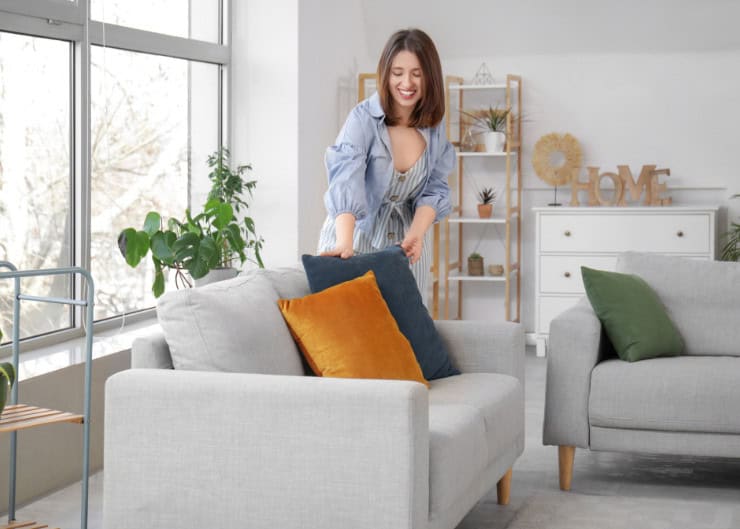In the competitive world of real estate, staging your home is a crucial step in attracting potential buyers. According to Realtor.com, homes sell 88% faster and for 20% more when they are staged!
A well-staged home not only showcases its best features, but also helps buyers envision themselves living there. However, staging can often come with a hefty price tag. Fear not! With a bit of creativity and strategic planning, you can stage your listing on a budget without compromising on style or appeal. Today, we’ll explore some savvy tips and tricks to help you stage your listing affordably.
Declutter and Depersonalize and Deep Clean:
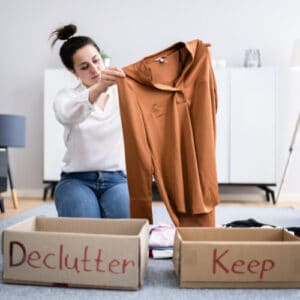 Before diving into staging, start by decluttering and depersonalizing your space. Remove personal items, excessive furniture, and clutter to create a clean canvas for potential buyers to envision themselves in the home. This step costs nothing but time and effort and is essential for creating a blank slate for staging.
Before diving into staging, start by decluttering and depersonalizing your space. Remove personal items, excessive furniture, and clutter to create a clean canvas for potential buyers to envision themselves in the home. This step costs nothing but time and effort and is essential for creating a blank slate for staging.
This can often be the hardest step for sellers. You are often still living in the house while trying to sell it, and it can feel strange living in your home when it’s devoid of your personality. There’s a sense of security and comfort living amongst your prized possessions and seeing the faces of your friends and family smiling at you from their frames. This is exactly the first point we are making; these things make it feel like your home. When you have your house listed for sale, you want to make the buyer see the potential it has for becoming their next home, rather than them feeling like they are visiting yours.
It may be easier for you to start with a round of decluttering before tackling your personal items. Your goal is to make each room feel as open and airy as possible. For the duration of the time your house is on the market, laundry can either be in the hamper, neatly put away, or in the washer or dryer until the timer dings.
In the kitchen, clear everything off the top of the fridge, and clear the appliances off the countertops. Dishes are either being used, are in the dishwasher, or are neatly stored in the cabinet. Pack away anything you won’t be needing in the near future. Having a lot of clutter in the kitchen gives the appearance that there isn’t enough storage space.
Books and magazines should either be displayed nicely on shelves, and not laying haphazardly on the coffee table or stacked on the floor. You may even consider donating the ones you no longer need! (That’s a hard one for me!) If you don’t typically abide by the rule “a place for everything, and everything in its place”, you need to get yourself in that mindset for the time being!
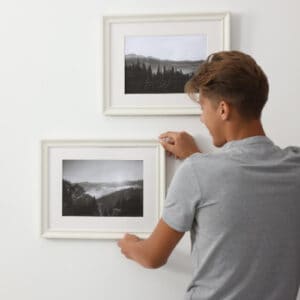 Once you have all surfaces clear of clutter, including the floor, let’s go back and revisit removing personal items. This is often the time it really hits home that you are not going to be living in your house much longer. It’s ok to be sad or anxious about your upcoming move, but let’s focus on the fact that your home has served you well, and now you need to get it ready to do the same for the next owner.
Once you have all surfaces clear of clutter, including the floor, let’s go back and revisit removing personal items. This is often the time it really hits home that you are not going to be living in your house much longer. It’s ok to be sad or anxious about your upcoming move, but let’s focus on the fact that your home has served you well, and now you need to get it ready to do the same for the next owner.
Remove all family and friends’ photos, clear the fridge of kids’ artwork, and stow away any fan memorabilia proudly on display. As you pack these items, consider it a head start on your move – you were going to box them up eventually, so why not get a jump on it now?
The final touch is a thorough deep clean of your home, from top to bottom. Cobwebs and dirty surfaces are definite turn-offs for potential buyers. It’s essential to evoke the image of a pristine, well-maintained living space, rather than one requiring immediate housework. Even if your housekeeping skills aren’t exceptional, channel your inner Cinderella during the selling process. Alternatively, enlist the help of a professional cleaner to ensure your home shines its brightest for potential buyers.
Now that we have a clean, blank canvas to work with, let’s get it staged!
Focus on Key Areas:
Instead of staging the entire house, focus on key areas that make the biggest impact, such as the living room, kitchen, and the primary bedroom. By allocating your resources strategically, you can achieve maximum impact without overspending. These are the areas where buyers tend to spend the most time, so prioritize them for staging.
In the primary bedroom, remove any bulky furniture, such as headboards and/or foot boards, or the dresser in the corner that eats up a lot of space. Buyers want to be able to visualize how their furniture is going to fit in the space, and if you have wall-to-wall furniture packed in there, it’s going to be hard for them to see past it.
This is also the time to remove the workout gear/ exercise bike (clothes rack???) from your bedroom. If you have a bonus space somewhere in the house you can stage as a dedicated gym area, great! If not, move it to the garage, or see if it can live with a friend or family member until you buy your next home. If you can’t remember the last time you even used any of this stuff, sell it and put the funds towards your staging project!
Same goes for the living room. Remove anything that doesn’t belong, and make sure you also rearrange furniture to optimize space and flow. Potential buyers should be able to move freely about the space without having to worry about stubbing a toe, or cracking their shins on a table. Set up “conversation zones” by arranging seating so it’s facing one another so people can comfortably sit and chat. This creates a sense of coziness and makes the room feel inviting.
The kitchen is really simple. Have out a fresh dish towel, a colorful bowl of fruit and/or flowers, and perhaps a cute little cutting board display in a cornet. The most important things for the kitchen are to have the countertops clear, have it sparkling clean, and as light and bright as you can get it. (See our lighting tips below!)
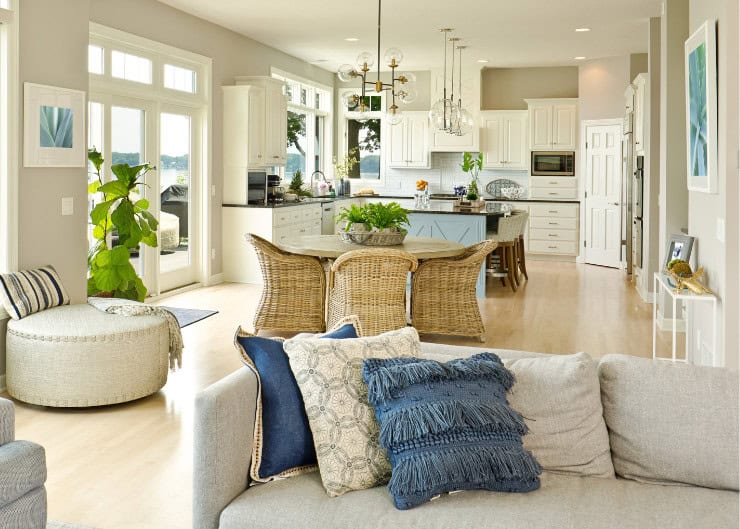
DIY Décor:
The Dollar Store, Dollar General, and thrift stores are great resources for finding artwork and knickknacks at a really low price, if your space is feeling a little sparse after you decluttered and removed all your personal effects. They can be used as-is, or as the start of a DIY project. Remember though, the more you add back in, the more you are going to have to keep clean!
Repurpose Furniture:
 Instead of splurging on new furniture, repurpose items you already own or borrow pieces from friends and family. Remove any bulky pieces that eat up a lot of space, or are currently living in a room because you had no other place to put them. Once you have everything out that doesn’t belong, assess the space and decide what it needs. If your coffee table was a beast, see if your bestie will let you trade for her streamlined one for now.
Instead of splurging on new furniture, repurpose items you already own or borrow pieces from friends and family. Remove any bulky pieces that eat up a lot of space, or are currently living in a room because you had no other place to put them. Once you have everything out that doesn’t belong, assess the space and decide what it needs. If your coffee table was a beast, see if your bestie will let you trade for her streamlined one for now.
Take a look around your house and see if there are pieces that can be used in another room. Maybe an end table becomes a nightstand, or vice versa. Do you have tables or chairs stored in your garage or attic? See if you can swap them out for what you are currently using to give the room a more neutral feel. Did you recently get a new couch in the basement? Maybe it will look better staged in the living room. We are creatures of habit and once we give something a purpose, it is hard to envision it anywhere else. Look around your house with fresh eyes and see if you can swap some things out to freshen up the space.
On another note, not all parts on a piece of furniture wear the same. Has your kitchen hutch seen better days? Remove the top piece, and use the base as a buffet in the dining room! Got a dresser to get rid of? Repurpose the drawers into cute wall shelves!
Consider using multi-functional pieces that serve both practical and aesthetic purposes. One of the most versatile pieces to use in a living room is the Pouf. Is it a seat? An ottoman? A side table? Who cares?? Use it for whatever the situation calls for! Plus, they are often made in fun prints and shapes that add a bit of interest to the space.
With a bit of creativity, you can achieve a stylish look without spending a dime on new furniture!
Strategic Lighting:
Proper lighting can make a significant difference in how a space looks and feels. Maximize natural light by removing heavy curtains and opening blinds or curtains during showings. Turn on all the lights and make your home as light and bright as possible!
Additionally, strategically placed lamps and inexpensive light fixtures can brighten up dark corners and highlight key features of your home. Did you know that there are three layers of lighting? Ambient, task, and accent lighting work together to create a balanced feel to the room. For ambient lights, think can lighting, chandeliers, and pendant lights. Task lighting is used to help you see, well, your tasks. Think table and floor lamps in the living areas for reading and such, and under-cabinet lighting in kitchens to light up your prep work. Accent lighting rounds it out by shedding light on accent pieces. Think library lights over bookshelves or gallery lights over paintings.
Again, focus on the main areas of the home first (kitchen, family room, and primary suite) and really make those areas shine! Scope out what you already have, ask friends and family to lend you a lamp or two, or hit up your local thrift store.
Accessorize Thoughtfully:
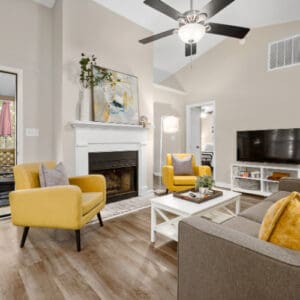 Add pops of color and texture through carefully curated accessories such as throw pillows, rugs, and decorative accents. Shop smart by browsing thrift stores, discount retailers, and online marketplaces for affordable finds that complement your staging aesthetic. If you already have pillows, shop Amazon for inexpensive covers.
Add pops of color and texture through carefully curated accessories such as throw pillows, rugs, and decorative accents. Shop smart by browsing thrift stores, discount retailers, and online marketplaces for affordable finds that complement your staging aesthetic. If you already have pillows, shop Amazon for inexpensive covers.
Mixing and matching different textures and patterns can add depth and visual interest to your space without breaking the bank. Don’t go overboard here though. You want to stick to a neutral pallet with a few pops of color here and there, and make sure your theme is cohesive throughout the house. You don’t want it to be too jarring as you go from one room to the next. It should flow nicely and feel connected.
Also, don’t overdo it! Remember, nice clear surfaces are inviting and appealing to potential buyers. Don’t go nuts trying to find knick knacks for every inch of space. You want just a few items that will allow the eye to go from one to the next without being overwhelmed.
Enhance Curb Appeal:
The majority of the work is going to cost you some time and very little money. Mow the grass, trim the hedges, weed the flower beds, and powerwash the siding. Make sure that the path to the front door is cleared and there are no tripping hazards for buyers as they make their way to the front door. Make sure porch lights are working and turned on for evening appointments.
Enhancing curb appeal can make a lasting first impression on potential buyers. Simple upgrades like freshening up the landscaping, painting the front door and shutters, and adding potted plants or flowers can instantly elevate the look of your home without costing a fortune.
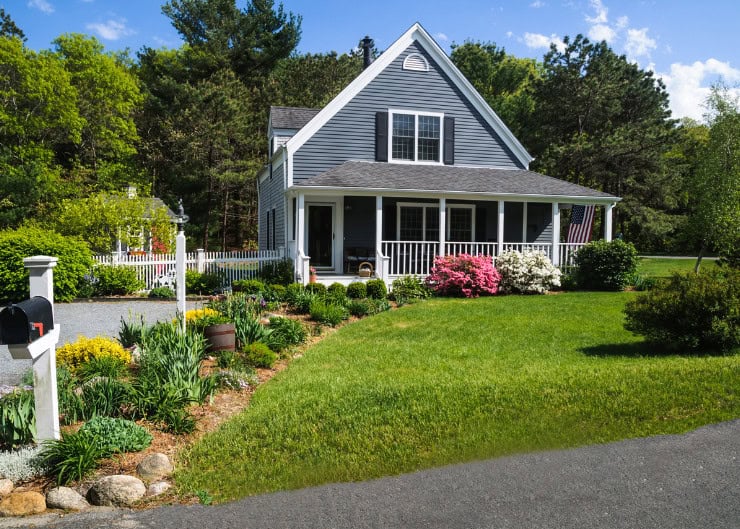
Virtual Staging:
Oftentimes you will be paying by the room to have it virtually staged. It isn’t necessary to have every room done, so again, focus on the big ones: the kitchen, living room, and primary bedroom. A really cool tip we picked up is to take the virtually staged photos and print them out, then frame them and have them in the empty room for buyers to see while they are touring the home. This helps them get a feel for how the space looks with furniture in it.
By following these budget-friendly tips to stage your home, you can showcase your listing in the best possible light without breaking the bank. With a little creativity and strategic planning, you can make a lasting impression on potential buyers and increase your chances of a successful sale. Remember, staging is all about highlighting your home’s best features and creating an inviting atmosphere that resonates with buyers. With Mr. Lister Realty by your side, you can sell smart and achieve your real estate goals without overspending.

